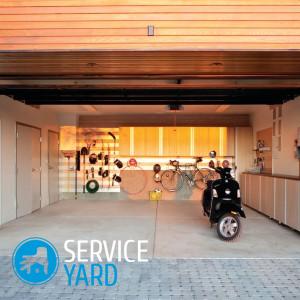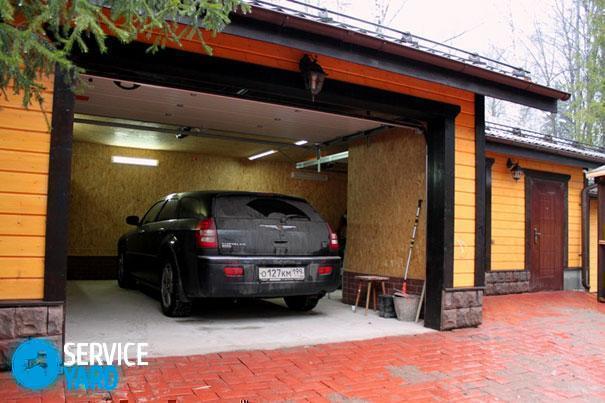Damp in the garage

Probably, all owners of garages are familiar with the problem of condensation. The importance of this issue can not be discussed, because moisture in the garage is always associated with great inconvenience and additional costs. How can dampness in a garage be eliminated at minimal cost — this will be discussed in this article.
to contents ↑Getting to the fight
Before you plan activities to “drain” the room, you need to understand what is the reason for the increased humidity. Most often, the cause of dampness in the garage are:
- lack of ventilation - hoods are clogged or flaws were allowed at the construction stage;
- poor condition of waterproofing (earthen floor without concreting).
to contents ↑Important! Garages with a viewing pit or cellar are usually damper.
What is the danger of dampness in the garage room?
At first glance, it may seem to you that it poses no danger. This is mistake. Excess moisture carries the following consequences:
- Harmful atmosphere. Toxic substances contained in oils and fuels evaporate more strongly in a humid room.
- Corrosion of metal objects, including your car.
- Excessive moisture sometimes even leads to the destruction of the brick structure.
How to eliminate dampness in the garage: basic methods
In accordance with the requirements of SNiP, the volume of fresh air must exceed 180 cubic meters per hour. Only in this case, the premises of your garage will be truly safe.
Important! Typical mistakes of garage owners trying to deal with high humidity: wall insulation, concrete concreting with overlapping ventilation openings. At the same time, unsatisfactory waterproofing is not taken into account. Such rash actions do not eliminate, but exacerbate the problem.
Ventilation fix
There are three ways to normalize the ventilation system of the garage.
Natural ventilation
This is the easiest and cheapest way to eliminate dampness in the garage. The principle of its action is the difference in temperatures outside and inside the garage, as well as the pressure difference between the outflow and the influx of air.
Important! No special skills and tools for setting up ventilation are required.
It is only necessary to observe such conditions:
- Buy pipes for ventilation, preferably made of polymer material.
- Make two holes in the garage wall. What is located in the lower part will serve for the flow of air. The hole in the upper part of the wall is designed for outflow of air.
Important! The method of making holes depends on what materials the garage walls are made of.
- Select the hole sizes so that they match the diameter of the pipes you bought.
- Install the pipes so that the upper one rises above the garage by 1500 mm, and the lower one goes towards the ground.
Mechanized ventilation
This method involves the use of fans - both exhaust and supply. The procedure in this case is as follows:
- Make ventilation holes in the same way as in the first method.
- Install two fans on both holes.
- Connect the resulting system to the power supply.
Important! Now, if you regularly turn on the fans, you will forget about condensation and dampness in the garage.
Combined ventilation
These are the two previous methods combined in one. You can make four holes in the wall of the garage, but four:
- two of them will serve for natural ventilation;
- and two - to work with fans.
Important! The only disadvantage of this method is that the garage room will be very cold.
A few nuances of arranging ventilation:
- The supply pipe must be installed at an angle. Its height from the floor is at least 0.2 m.
- The distance of the exhaust pipe from the roof of the garage should be 0.1-0.2 m.
Important! Subject to these rules, the air circulation will be correct, and the air will be constantly dry.
How to eliminate dampness in the garage: the secrets of high-quality waterproofing
Properly equipped waterproofing will help to quickly get rid of high humidity in the garage room. There are two ways of high-quality waterproofing, performed independently.
Additional layer of waterproofing material
This method is relevant if the foundation was originally laid incorrectly. The algorithm is as follows:
- Buy bitumen mastic. Before using it, carefully read the instructions.
- Cover the foundation with mastic.
Important! If you did everything right, the garage will dry quickly.
Concreting the inspection pit and garage floor
The procedure in this case is as follows:
- Free the room completely.
- Remove debris from the floor, level the surface.
- Pour the floor with pre-prepared mortar.
Important! Often this is not enough to completely eliminate the dampness in the garage. It is necessary to warm the room and establish ventilation.
Additional ways to reduce humidity:
- Installation of air conditioning. It will help if the main causes of dampness have already been eliminated. The air conditioner maintains an optimal indoor climate and, in addition to the basic methods, reduces the level of humidity.
- Dry car. Make sure that there are no traces of snow or raindrops on the surface of the machine. The heaters installed in the garage room in the winter, as well as the split system equipped with the drain function, will help to combat this problem.
to contents ↑Important! If the garage is built on a site with high groundwater activity, no additional waterproofing, unfortunately, will help. The only way is to change the garage and not be too lazy to make all the necessary checks of the proposed premises before buying.
Dry the cellar
This event must be held before starting work on improving waterproofing. If you are interested in how to eliminate dampness in a garage, do not forget to tackle the cellar and the inspection pit.
Important! The best time for drying the cellar is summer, during the period of the highest air temperature.
Method 1
How to act:
- Clean the basement of all items.
- Now clean the floor and let it dry naturally for 2-3 days.
- Next will be direct drying:
- Firmly fix the old bucket in the central part of the cellar and start a fire in it.
- To make the fire burn better, make holes in the bottom of the bucket, make a brick stand. This increases your cravings.
Important! During combustion, the air in the basement warms up, as a result of which its natural circulation occurs. Removing humid air is fast enough.
Method 2
Another effective and easy way to dry is with a candle:
- Bring the pipe out from the cellar floor.
- Fasten the can to the candle and place it at the end of the pipe.
- For the first draft to appear, light a piece of paper at the end of the pipe. Further, the candle will support traction.
to contents ↑Important! Draining the cellar in this way lasts about 3 days. The candle can be replaced with dry fuel. The effect will be similar.
External drainage
Abstraction of groundwater outside the garage is a good way to drain it.
Important! It is desirable that external drainage was provided at the construction stage.
If this is not the case, the error can be fixed in another way:
- Dig a trench around the perimeter of the cellar floor. Its width and depth is 400-500 mm.
- Drill wells to the first sand layer at intervals of 2.0 m.
- Insert plastic tubes into the wells and cover with a metal fine-mesh grid.
- Lay the geotextile on the bottom and walls of the trench, with a lap on the edges.
- Fill the trench with gravel and crushed stone to a level slightly higher than the base of the cellar wall, carefully compact the gravel.
- Wrap gravel with geotextile edges. It turns out a kind of drainage pipe, which prevents the accumulation of groundwater.
Fill the structure with the remaining gravel and carefully compact.
to contents ↑Cellar internal drainage
The procedure is as follows:
- Remove the floor covering, dig a trench 50 cm deep along the perimeter of the floor.
- Tamp and line the bottom of the trench with a moisture absorbing geoseptic material.
- Fill the trench with gravel 150-200 mm thick.
- Lay pipes on the gravel (1 m slope is 3 mm).
- Fill the trench over the pipes with gravel. Gravel should be used of medium size so that small pebbles do not clog holes. Next up is the geotextile layer.
- Fill the structure with sand or soil.
- Find the lowest point in the cellar and equip a well to collect groundwater. This can be an industrial PVC collector, or a self-made design.
- Install a drainage pump in the well equipped with an automatic switch-on and an automatic switch-off at the end of pumping.
- Connect a hose to the pump to drain water into the sewer system or off site.
Modern method
The modern injection method is also effective - pumping waterproofing material into pre-drilled holes. The following materials are used for pumping:
- Epoxy
- Polyurethane
- Acrylate.
- Microcements.
The most effective are acrylate and polyurethane materials. Their density is comparable to water, so they are able to penetrate the smallest voids in the structure of the material.
to contents ↑Important! The procedure is quite expensive. It can only be performed by professionals.
Stock footage
To defeat the dampness in the garage, it is necessary to approach the issue in a comprehensive manner. Watch the condition of the ventilation system and waterproofing. Only the proper operation of these systems will allow you to achieve a favorable microclimate in the garage.
- How to choose a vacuum cleaner taking into account the characteristics of the house and coatings?
- What to look for when choosing a water delivery
- How to quickly create comfort at home - tips for housewives
- How to choose the perfect TV - useful tips
- What to look for when choosing blinds
- What should be running shoes?
- What useful things can you buy in a hardware store
- Iphone 11 pro max review
- Than iPhone is better than Android smartphones



